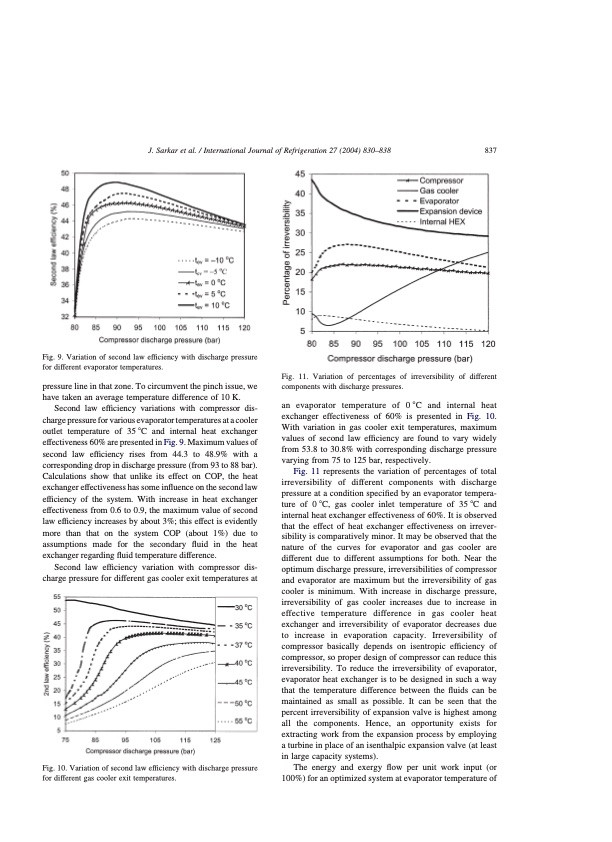
PDF Publication Title:
Text from PDF Page: 008
J. Sarkar et al. / International Journal of Refrigeration 27 (2004) 830–838 837 Fig. 9. Variation of second law efficiency with discharge pressure for different evaporator temperatures. pressure line in that zone. To circumvent the pinch issue, we have taken an average temperature difference of 10 K. Second law efficiency variations with compressor dis- charge pressure for various evaporator temperatures at a cooler outlet temperature of 35 8C and internal heat exchanger effectiveness 60% are presented in Fig. 9. Maximum values of second law efficiency rises from 44.3 to 48.9% with a corresponding drop in discharge pressure (from 93 to 88 bar). Calculations show that unlike its effect on COP, the heat exchanger effectiveness has some influence on the second law efficiency of the system. With increase in heat exchanger effectiveness from 0.6 to 0.9, the maximum value of second law efficiency increases by about 3%; this effect is evidently more than that on the system COP (about 1%) due to assumptions made for the secondary fluid in the heat exchanger regarding fluid temperature difference. Second law efficiency variation with compressor dis- charge pressure for different gas cooler exit temperatures at Fig. 10. Variation of second law efficiency with discharge pressure for different gas cooler exit temperatures. Fig. 11. Variation of percentages of irreversibility of different components with discharge pressures. an evaporator temperature of 08C and internal heat exchanger effectiveness of 60% is presented in Fig. 10. With variation in gas cooler exit temperatures, maximum values of second law efficiency are found to vary widely from 53.8 to 30.8% with corresponding discharge pressure varying from 75 to 125 bar, respectively. Fig. 11 represents the variation of percentages of total irreversibility of different components with discharge pressure at a condition specified by an evaporator tempera- ture of 0 8C, gas cooler inlet temperature of 35 8C and internal heat exchanger effectiveness of 60%. It is observed that the effect of heat exchanger effectiveness on irrever- sibility is comparatively minor. It may be observed that the nature of the curves for evaporator and gas cooler are different due to different assumptions for both. Near the optimum discharge pressure, irreversibilities of compressor and evaporator are maximum but the irreversibility of gas cooler is minimum. With increase in discharge pressure, irreversibility of gas cooler increases due to increase in effective temperature difference in gas cooler heat exchanger and irreversibility of evaporator decreases due to increase in evaporation capacity. Irreversibility of compressor basically depends on isentropic efficiency of compressor, so proper design of compressor can reduce this irreversibility. To reduce the irreversibility of evaporator, evaporator heat exchanger is to be designed in such a way that the temperature difference between the fluids can be maintained as small as possible. It can be seen that the percent irreversibility of expansion valve is highest among all the components. Hence, an opportunity exists for extracting work from the expansion process by employing a turbine in place of an isenthalpic expansion valve (at least in large capacity systems). The energy and exergy flow per unit work input (or 100%) for an optimized system at evaporator temperature ofPDF Image | Optimization of a transcritical CO2 heat pump cycle

PDF Search Title:
Optimization of a transcritical CO2 heat pump cycleOriginal File Name Searched:
transcritical-co2-heat-pump.pdfDIY PDF Search: Google It | Yahoo | Bing
CO2 Organic Rankine Cycle Experimenter Platform The supercritical CO2 phase change system is both a heat pump and organic rankine cycle which can be used for those purposes and as a supercritical extractor for advanced subcritical and supercritical extraction technology. Uses include producing nanoparticles, precious metal CO2 extraction, lithium battery recycling, and other applications... More Info
Heat Pumps CO2 ORC Heat Pump System Platform More Info
| CONTACT TEL: 608-238-6001 Email: greg@infinityturbine.com | RSS | AMP |